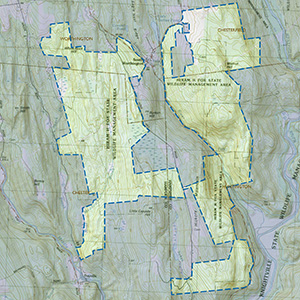Important Bird Area Sites in Massachusetts
Important Bird Area: Hiram Fox Wildlife Management Area
Site Summary
Nominated By
Brad Blodgett
Size
1,000 acres
Towns and Counties
Chester, Huntington, Worthington; Hampden, Hampshire
Ownership
MassWildlife
Major Habitats
northern hardwoods 60%, oak-conifer 40% (palustrine wooded swamp, emergent fresh-water wetland, river/stream)
Land Use
nature & wildlife, conservation/land trust, hunting & fishing, forestry, research, undeveloped
Minor Threats
natural pets/disease, cowbird parasitism
IBA Criteria
- Category 5: Sites important for long-term research and/or monitoring projects that contribute substantially to ornithology, bird conservation, and/or education.
Site Description
The entire area comprises 3,200 acres of second-growth forest spread over four towns. The nominated site is a portion of this entire area (approximately 1,000 acres) and is located predominantly in Chester. The site comprises relatively unfragmented forest with a limited amount of agriculture and rural development in the surrounding areas. Topography is characterized by moderate and occasional steep slopes, interspersed with upland and abrupt ledge outcrops. The proposed site lies within the Westfield watershed and is interspersed with annual streams. Habitats within the area are primarily northern hardwoods (60%) with scattered occurrences of mixed northern hardwood/northern red oak (10%), mixed white pine/hardwoods (20%), and hemlock/hardwoods (10%). The proposed IBA is exclusively forested, except for an interspersion of Beaver impoundments along the Moss Meadow Brook drainage totaling approximately 13 acres of upland forest, forested wetlands totaling approximately 30.3 acres, and at least 11 vernal pools. The overall wetland area is 44.4 acres or about 5% of the study area.
Current Conservation Status
A state wildlife management area.
Threats: Natural Pests and Disease: As of 2001, Hemlock Woolly Adelgid has not been observed on the property, but if and when it arrives it would have a substantial impact on the nesting birds of the hemlock stands.
Cowbird Parasitism: Cowbird impact on nesting success is likely quite minimal here in this unfragmented forest. Limited forestry work and natural openings created by Beavers, fire, and storms are likely to create openings that could serve as cowbird entry areas.
Encroachment of housing development on bordering private lands: Housing development and gradual encroachment on the property boundaries are the greatest threats to the area. Since the original 1,000-acre property was acquired in 1962, additions to the property have been made, resulting in a current total in the wildlife management area of more than 3,000 acres. Continued acquisitions and conservation ownership of other lands in the area should help to limit and minimize the amount of encroachment.
Ornithological Significance
The site was specifically selected for a long-term breeding study of forest-nesting birds. The study is designed to be replicable, long-term, and open-ended using established stations along transects through the forest, and to establish accurate trend information on neotropical migrant land birds from annual census. The study, begun in 1987, uses standard point count survey methods. In thirteen survey years the 100-station subsample has produced a mean of 1,119 individuals, representing 58 species. At all 336 stations, 102 species have been recorded on the proposed IBA. During 2001 the ten most abundant species derived from the results were (abundance in parentheses) Yellow-bellied Sapsucker (35), Red-eyed Vireo (217), Ovenbird (183), Black-throated Green Warbler (94), Veery (68), Wood Thrush (47), American Redstart (38), Black-and-white Warbler (32), and Black-throated Blue Warbler (26). The area contains breeding populations of both state and regional high conservation priority species. This site was proposed for consideration for an IBA because of the long-term study in progress. Regrowth of forest clearings seems to be responsible for a decrease in species richness. In the early 1990s, forest clear-cuts and subsequent burns to maintain the clearings resulted in the appearance of nesting Mourning Warblers and a spectacular spike in the number of Chestnut-sided Warblers. These classic "fugitive species," as well as other early successional species such as the Alder Flycatcher, Eastern Kingbird, Gray Catbird, Indigo Bunting, and White-throated Sparrow have declined and have disappeared or have been reduced to trace occurrences. Numbers of deep forest species have mostly remained consistently robust.
Other Flora or Fauna of Significance
None mentioned.
Data Sources
Source of data is exclusively MassWildlife file data collected on the property since 1987 and compiled by B. Blodgett.




